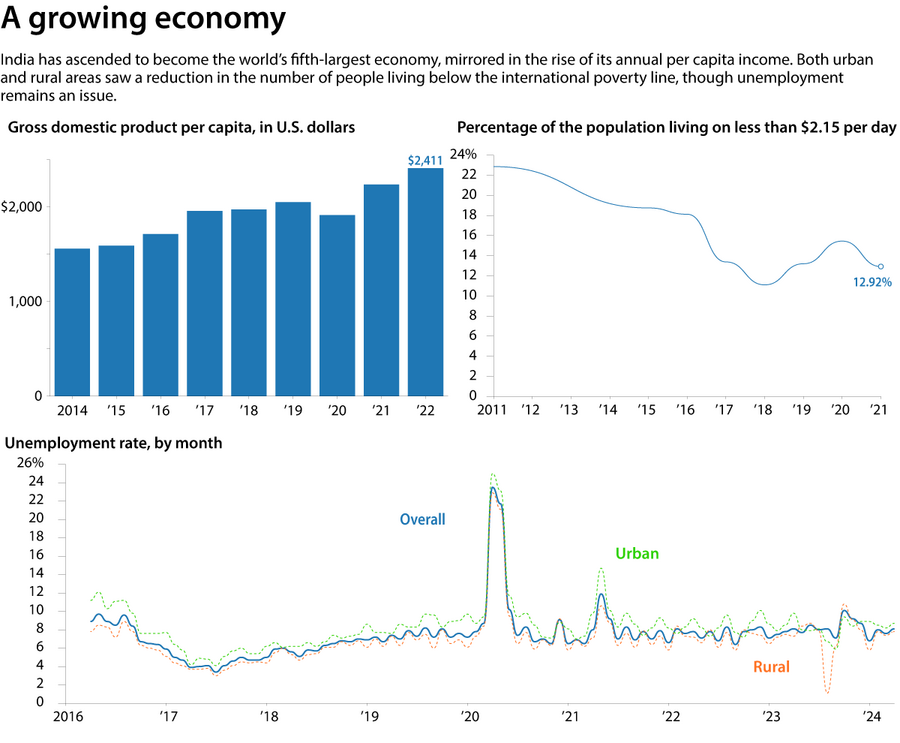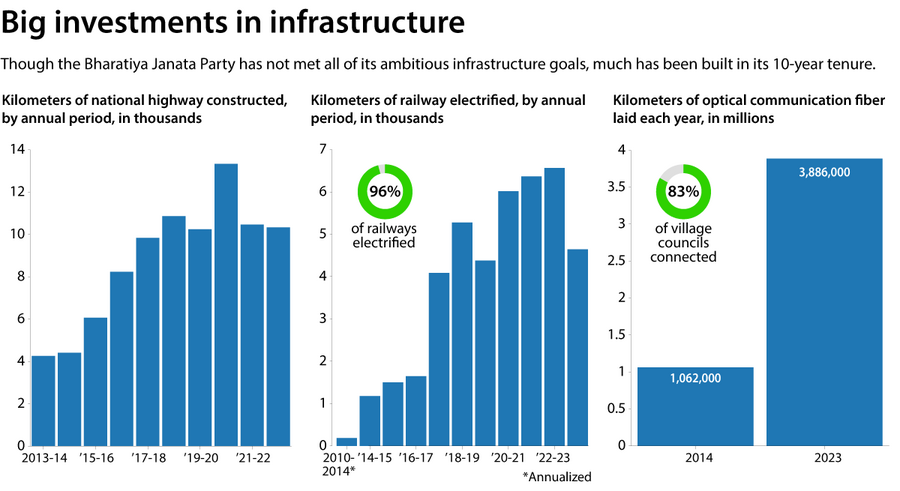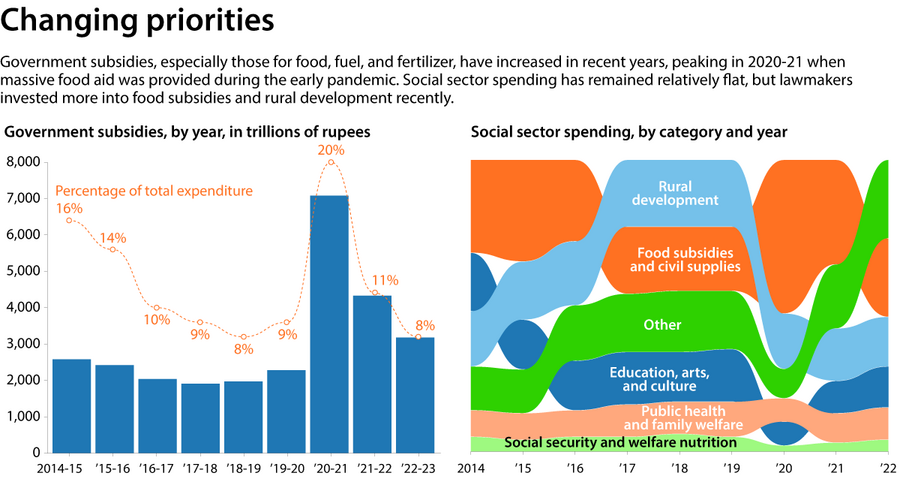Even before his latest victory, Modi was reshaping India. These numbers show how.
Loading...
India’s sitting Prime Minister Narendra Modi is set to return for a third term after a closer-than-expected Lok Sabha race.
As results from the world’s largest-ever election trickled in late Tuesday evening, it became clear that Mr. Modi’s Bharatiya Janata Party had failed to claim the 272 seats needed for an outright majority in Parliament, a verdict the opposition alliance is calling a moral defeat. But with the BJP winning well over 200 seats and vowing to form a coalition government, the party will continue to wield significant power over the next five years – with Mr. Modi at the helm.
In his first reaction after the results, Mr. Modi thanked his party workers and declared that the BJP “will continue the good work done in the last decade to keep fulfilling the aspirations of people.” Since coming to power in 2014, Mr. Modi has promised Indians greater prosperity at home and a stronger image of the country abroad. In some ways, his government has moved the needle forward. But during Mr. Modi’s rule, India has also witnessed a major democratic decline, with the U.S. nonprofit Freedom House stating last year that democracy was “losing ground” in India due to government crackdowns against dissent and democratic values.
Why We Wrote This
A story focused onWith India’s weekslong election over, Prime Minister Narendra Modi’s last two terms can offer insight into the incoming government’s economic, infrastructure, and welfare agenda – and the future of press freedom in India.
These were issues the opposition raised repeatedly on the campaign trail.
“I think it’s a rap on the knuckles from the voters,” says Neelanjan Sircar, senior fellow at the New Delhi-based think tank Centre for Policy Research, about the election results.
Still, he says the BJP has claimed “a formidable number” of seats, and will guide the national agenda, as it has for the past decade.
Economic growth, static unemployment
Over the last 10 years, India has been one of the fastest-growing large economies, with an annual gross domestic product growth rate averaging 5.6% from 2014 to 2022. Meanwhile, extreme poverty decreased from 18.7% in 2015 to 12% in 2021, according to World Bank data.
The Modi government attributes this progress to various health and employment programs it launched for the general populace. Yet the government has also struggled to create productive jobs for its large unskilled labor force. In 2021, nearly half of workers remained in the low-paying agriculture sector, which generated about 17% of the nation’s GDP that year.
Despite efforts to boost local manufacturing and other jobs, India’s unemployment rate reached a 45-year high of 6.1% in 2017-2018, and surged to 20.8% during the COVID-19 pandemic before decreasing in recent years. Unemployment and inflation remain significant concerns for many voters, and the challenging labor market was a central issue for opposition parties targeting the Modi government during the election.
Infrastructure push gains momentum
Under Mr. Modi, India has witnessed significant strides in infrastructure development, marked by the expansion of national highways, airports, port capacity, and the optical fiber network, as well as railway electrification. These advancements have enhanced connectivity, supported economic growth, and aimed to bridge the rural-urban divide. Yet the government often fell short of its ambitious targets, revealing gaps in execution and planning.
In the railway sector, for example, Mr. Modi vowed to completely electrify India’s railway tracks by 2022. Although his government’s progress has dramatically outpaced the last government’s, that goal of full electrification remains unmet today. Efforts to double India’s highways and port capacity have also met roadblocks.
While the rapid development reflects the Modi administration’s strong commitment to infrastructure, experts say these unmet goals highlight the need for more effective strategies to fully realize the country’s infrastructure potential.
Modi’s welfare boom
The Modi government has prioritized the efficient delivery of public goods and social welfare programs, with an emphasis on reducing corruption. A significant achievement was the near-universal enrollment of Indian adults in the Aadhaar system, a digital ID program used to facilitate direct transfers of money to bank accounts.
The government’s commitment to welfare was particularly evident during the COVID-19 pandemic, when food aid surged nearly fivefold between 2019-2020 and 2021-2022, ensuring widespread access to affordable food grains.
Additionally, the percentage of people owning bank accounts rose from 48.3% in 2014 to 71.1%, driven largely by the need to receive subsidies.
These comprehensive welfare measures and extensive cash transfers have bolstered the BJP’s popularity among marginalized groups, which had traditionally supported the opposition Congress party.
Declining press freedom
India’s 21-spot fall in the Press Freedom Index rankings highlights growing restrictions on journalistic activity, as well as a broader trend of shrinking space for dissent – one that experts believe will continue during a third term.
Under the BJP, journalists’ access to the government has been restricted, with Mr. Modi largely avoiding holding press conferences.
Foreign journalists in India have faced stringent permit requirements, especially in sensitive regions like Kashmir and Assam, and the persecution of local journalists has increased more than fourfold since Mr. Modi took office.
At least 36 journalists were imprisoned between 2014 and 2023, compared with eight during the previous Congress-led government. A vaguely written terror law known as the Unlawful Activities (Prevention) Act was used to detain 16 of these journalists – seven of whom, including this reporter, were from Kashmir – highlighting the intensification of state control over the press. Several activists and journalists were also barred from traveling outside the country.









